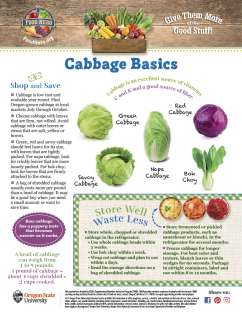Cabbage Basics
Cabbage is an excellent source of vitamins C and K and a good source of fiber.
Shop and Save
- Cabbage is low cost and available year round. Find Oregon-grown cabbage at local markets July through October.
- Choose cabbage with leaves that are firm, not wilted. Avoid cabbage with outer leaves or stems that are soft, yellow or brown.
- Green, red and savoy cabbage should feel heavy for its size, with leaves that are tightly packed. For napa cabbage, look for crinkly leaves that are more loosely packed. For bok choy, look for leaves that are firmly attached to the stems.
- A bag of shredded cabbage usually costs more per pound than a head of cabbage. It may be a good buy when you need a small amount or want to save time.
Raw cabbage has a peppery taste that becomes sweeter as it cooks.
Cabbage Math
A head of cabbage can weigh from 1 to 9 pounds. 1 pound of cabbage = about 4 cups shredded = 2 cups cooked.
Store Well Waste Less
- Store whole, chopped or shredded cabbage in the refrigerator.
- Use whole cabbage heads within 2 weeks.
- Use bok choy within 1 week.
- Wrap cut cabbage and plan to use within 2 days.
- Read the storage directions on a bag of shredded cabbage.
- Store fermented or pickled cabbage products, such as sauerkraut or kimchi, in the refrigerator for several months.
- Freeze cabbage for longer storage. For best color and texture, blanch leaves or thin wedges for 90 seconds. Package in airtight containers, label and use within 8 to 12 months.
Enjoy Cabbage
Recipes
Sautéed Cabbage
Tuna Cabbage Salad
Garlic Bok Choy
Kids Can!
When kids help make healthy food, they are more likely to try it. Show kids how to:
- help write a grocery list for a Food Hero recipe.
- peel the outer leaves from a head of cabbage.
- measure and mix ingredients.




